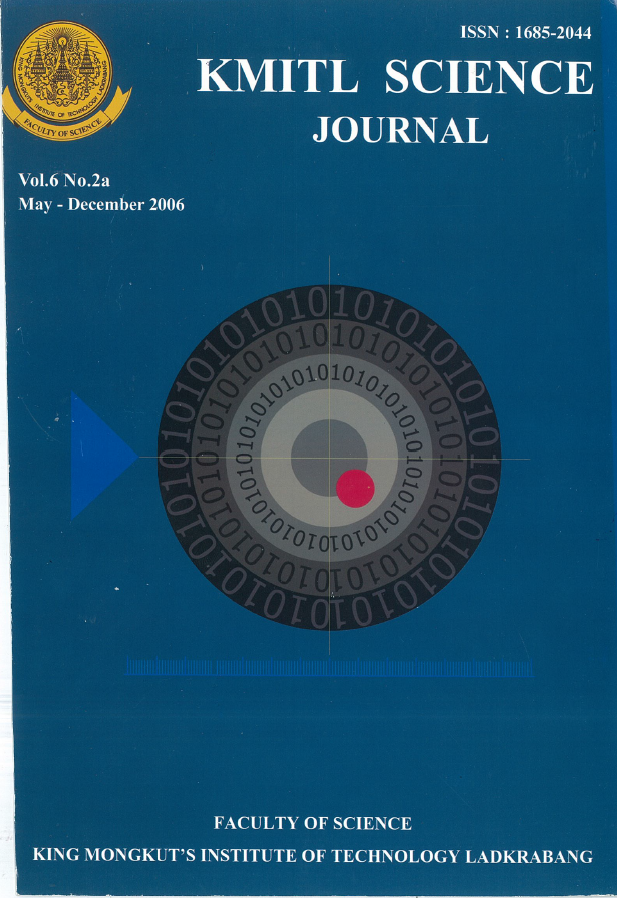Multi-Response Evolutionary Operations with Taguchi Parameter Designs For Automatic Electrostatic Painting System
Main Article Content
Abstract
Evolutionary Operations (EVOP) or Response Surface Methodology (RSM) is a method for finding the optimal conditions of industrial processes. In general, this approach will search for the proper conditions under a consideration of a uni-response system. This work determines the efficiency of a proposed sequential algorithm in the context of RSM for automatic optimisation of metallic painting parameters for aluminium alloy wheels via Taguchi parameter design. The study categories the area on wheel into four zones and there are then four responses. The metallic painting system in this work uses an automatic electrostatic painting (AEP) spray gun and there are seven parameters (controllable predictor variables) that effect the metallic paint thickness including colour shade. To improve metallic painting parameters via Taguchi design we do study the interaction of each parameter to create linear graph of interaction for all parameters. This brings an orthogonal array of the specific experiments. By referred past records we can design lower and upper levels of each parameter. The purpose of experimental designs is to find the relationship among parameters to paint thickness and colour shade on the wheel. All experimental data will be used to fit a multiple regression model for paint thickness in each zone. A sequence of runs is then carried out by moving in the direction of steepest ascent to approach the better responses. Optimisation strategy in this work will be applied on each significant path in each zone. The results suggest that the proposed levels pf predictor variables from the method of steepest ascent seems to be more efficient on the AEP surface when compared with the same preset levels. The EVOP based on Taguchi design works well on both the average and the standard deviation of the thickness when the responses are determined in areas zoned Z1, Z2 and Z4. Although the average and the standard deviation of the responses in zone Z3 after the EVOP are not satisfied, it is at the same level, on average, when compared. Under a consideration of customer’s requirement on paint thickness and colour shade of the wheel, experimental analyses on metallic painting parameters also bring the reduction of metallic paint consumption in each wheel during the manufacturing process.
Keywords: evolutionary operations, response surface, Taguchi parameter design, multiple regression, steepest ascent
Corresponding author: E-mail: lpongch@engr.tu.ac.th
Article Details
Copyright Transfer Statement
The copyright of this article is transferred to Current Applied Science and Technology journal with effect if and when the article is accepted for publication. The copyright transfer covers the exclusive right to reproduce and distribute the article, including reprints, translations, photographic reproductions, electronic form (offline, online) or any other reproductions of similar nature.
The author warrants that this contribution is original and that he/she has full power to make this grant. The author signs for and accepts responsibility for releasing this material on behalf of any and all co-authors.
Here is the link for download: Copyright transfer form.pdf
References
[2] Box, G.E.P. 1957 Evolutionary Operation: a Method for Increasing Industrial Productivity. Applied Statistics, 6, 81-101.
[3] Box, G.E.P. and Draper, N.R. 1969 Evolutionary Operation A Statistical Method for Process Improvement, John Wiley, New York.
[4] Montgomery, D.C. 2001 Design and Analysis of Experiment. 5 th, John Wiley, New York.
[5] Brooks, S.H. 1959 A Comparison of Maximum-Seeking Methods, Operations Research, 7, 430-457.
[6] Brooks, S.H. and Mickey, M.R. 1961 Optimum Estimation of Gradient Direction in Steepest Ascent Experiments, Biometrics, 46, 48-56.
[7] Montgomery, D.C., and Evans, D.M. 1975 Second-order Response Surface Designs in Computer Simulation, Simulation, 25, 169-178.
[8] Myers, R.H. and Carter, W.H. 1973 Response Surface Techniques for Dual Response Systems, Technometrics, 15, 301-317.
[9] Vining, G.G. and Myers, R.H. 1990 Combining Taguchi and Response Surface Philosophies: A Dual Response Approach, Journal of Quality Technology, 22, 38-45.
[10] Del Castillo, E. and Montgomery, D.C. 1993 A Nonlinear Programming Solution to the Dual Response Problem, Journal of Quality Technology, 25, 199-204.
[11] Lin, D.K.J. and Tu, W. 1995 Dual Response Surface Optimisation, Journal of Quality Technology, 27, 34-39.
[12] Verbeek, C. J. R. 2002 The Young’s Modulus of Compression-Moulded LLDPE Phlogopite Composites, Published Doctor of Philosophy Thesis, University of Pretoria, South Africa.
[13] Hartjoy, L.D. 2002 Sequential Design of Experiments Combined with Taguchi Robust Parameter Design as an Efficient Process Improvement Methodology. Published Master Thesis, International Society of Robust Engineering Professional.
[14] Zeng, Z. 2003 Applications of POD Studies and Robust Design to Electromagnetic NDE Published Doctor of Philosophy Dissertation, Iowa State University, U.S.A.
[15] Ajaal, T.T. 2002 Development of Hydroxyapatite Scaffold for Artificial Bone Grafts. Published Doctor of Philosophy Thesis, Queen’s University Kingston, Canada.
[16] Chen, Y.H., Tam, S.C., Chen, W.L. and Zheng, H.Y. 1996 Application of Taguchi Method in the Optimisation of Laser Micro-Engraving of Photomasks, International Journal of Materials and Product Technology, 11, (3/4), 333-344.
[17] Otto, K.N. and Antonsson, F.K. 1993 Extensions to the Taguchi Method of Product Design, ASME Journal of Mechanical Design, 115(1), 5-13.
[18] Ansuj A. P., Dos Santos, C.R. and Radharamanan, R. 2002. Improving Process Quality Using of Factorial Design and Taguchi, Technical Report, Center of Mathematical Sciences, University of Santa Maria, Brazil.
[19] Peace, G. S. 1993 Taguchi Methods: A Hands-on Approach, Addison-Wesley Publishing Company, Reading.


